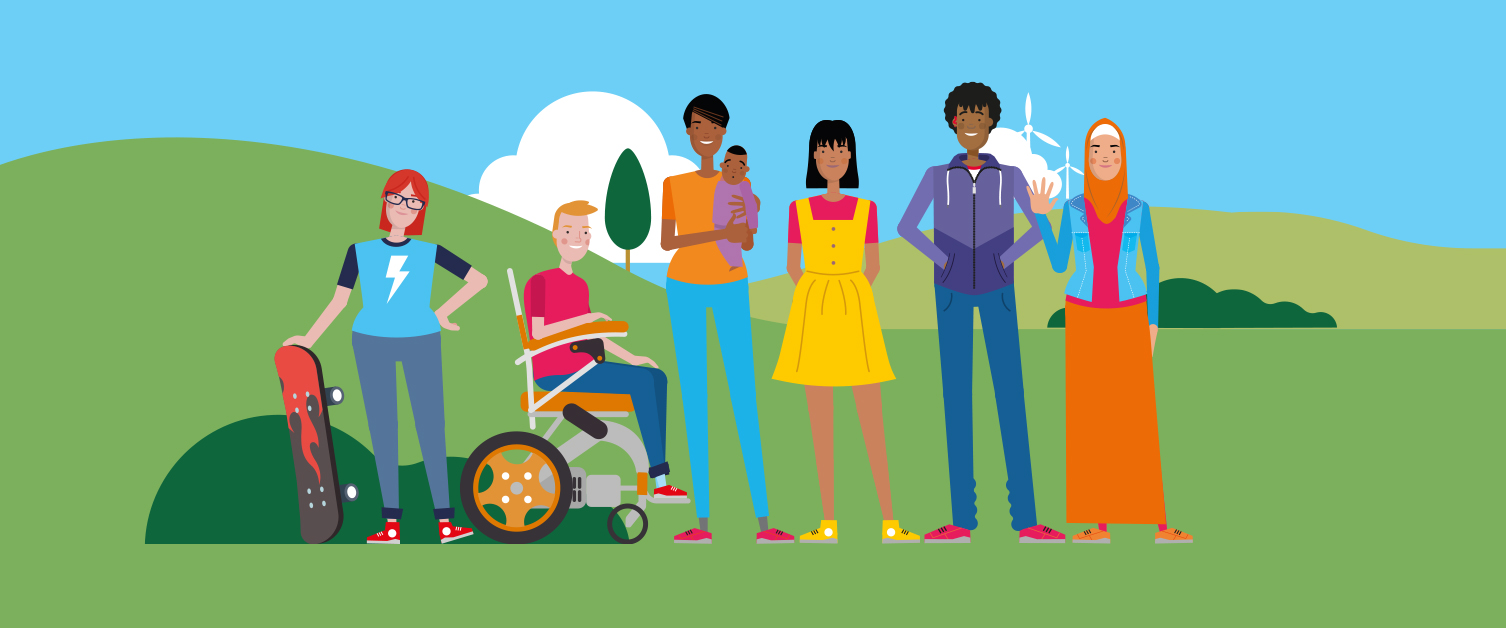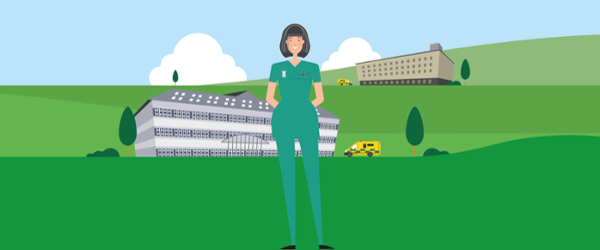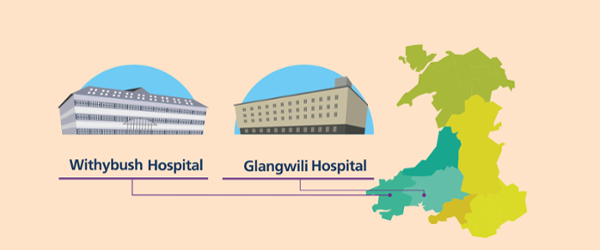Future Children Services Consultation Document

Thank you for your interest in the children and young peoples' services consultation. This consultation has now concluded.
We consulted with the public for 12 weeks from 26 May to 24 August 2023 on the future provision of health and care services for children and young people. You can find out more below.
You can also download a printable version here (opens in new tab).
The digitally accessible consultation document is below.
Thank you for your interest in Hywel Dda University Health Board’s consultation on how we provide urgent and emergency children and young people’s (paediatric) services for people who live in, or visit, areas that are serviced by Withybush and Glangwili hospitals. We are seeking your views on how best to provide these services following a series of temporary changes made since 2016.
Following these temporary changes, we now need to implement a longer-term solution. We have done a lot of work to narrow down the options for the services in the future and have three options that we would like your views on. It is our ambition that any changes introduced following this consultation will be in place until our proposed new urgent and planned care hospital, and our broader integrated health and care network, is established – as part of our strategy for ‘A Healthier Mid and West Wales: Our Future Generations Living Well’. You can read our strategy on A Healthier Mid and West Wales for more information. In this consultation we will ask you to tell us how suitable the three options are to deliver urgent and emergency children and young people’s services at Withybush and Glangwili hospitals will be delivered. At this stage, we do not have a preferred option for how urgent and emergency paediatric services at Withybush Hospital and Glangwili Hospital will be delivered between now and the establishment of the proposed new hospital network.
We would also like to hear your views on the positive and negative impacts associated with each of the three options, to help us avoid or reduce negative impacts. Details of the options can be found in this consultation document. For all three options, it is important to note that access to children’s emergency care will be retained at Glangwili Hospital’s emergency department, and minor injuries for children will continue to be treated at both Withybush and Glangwili hospitals. Also, systems are already in place to ensure that any child or young person with critical conditions arriving at Withybush Hospital has the best care available and in the most appropriate place. This will continue as part of the new service. However, our services are fragile, and this is partly because of how our hospitals are currently working, and how we are stretching our clinical teams across our two main hospitals. This is despite trying to recruit teams on many occasions to support these services.
This is now your chance to get involved and share your thoughts about the three options we are considering. Board members will consider all they have heard leading up to and during this consultation. Your views, along with other evidence and considerations, will help Hywel Dda University Health Board choose the most appropriate option for the future of urgent and emergency children and young people’s services at Withybush and Glangwili hospitals. Please read this document and come to our events to learn more about why we need to change, how we have reached this point, and how the three options can deliver these services.
We really want to hear the views of everyone in our communities – particularly current and future users of our paediatric services. Please tell us what you think about the options and provide us with answers to the questions that will help us decide on the best way forward for our children and young people’s services at Withybush and Glangwili hospitals. We are grateful to the staff, children and young people, and their parents and guardians, who have helped shape the process so far, and developed the three options we are consulting on.
Thank you,
Maria Battle - Chair
Professor Phil Kloer - Executive Medical Director and Deputy Chief Executive Officer
Lee Davies - Executive Director of Strategy and Planning
Hywel Dda University Health Board is your local health service provider. We plan, organise, and provide health services for almost 400,000 people across Carmarthenshire, Ceredigion, and Pembrokeshire.
We manage and pay for the care and treatment that children and young people receive for physical health, mental health, and learning disabilities.
Children and young people’s services are provided locally through:
- General Practices (GP surgeries)
- Community Pharmacies (chemists)
- Dental Practices
- Optometrist Practices
- Mental health and learning disability services
- care within your own homes
There is 24-hour access to paediatric services at Bronglais Hospital in Aberystwyth and Glangwili Hospital in Carmarthen for inpatients (people who stay one or more nights in hospital for treatment). Bronglais and Glangwili have emergency department facilities on the same site.
At Withybush Hospital in Haverfordwest and Prince Philip Hospital in Llanelli, there are 24- hour Minor Injury Units, which children can access. The Minor Injury Units can treat minor injuries in children over 12 months of age, which can include treatment for injuries such as animal or insect bites, minor burns, minor head injuries or scalp lacerations, foreign bodies in ear/nose, limb injuries, and minor eye injuries. Outpatient services for children (for children not needing immediate assessment, an overnight stay, or for those without longer term conditions) are available at Bronglais, Withybush, and Glangwili hospitals.

We want your views on how we provide urgent and emergency children and young people’s (paediatric) services for people who live in, or visit, areas that are serviced by Withybush Hospital and Glangwili Hospital.
This consultation document shares the three options for how urgent and emergency children and young people’s care at Withybush and Glangwili hospitals could be delivered in the future. Any changes made following this consultation would remain in place until the establishment of the proposed new urgent and planned care hospital in the area. A new urgent and planned care hospital is part of our strategy to be able to provide more care in community settings, by having a sustainable hospital model fit for future generations.
Between 23 February and 19 May 2023, we held a separate consultation and asked members of the public to share their views about three possible locations for the proposed new hospital in the south of the Hywel Dda area. The Board will consider the consultation responses, together with other information gathered about the shortlisted sites, and will make a decision on the best site for the proposed new hospital later this year. You can read more about the new hospital site consultation (opens in new window) on our website.
The development of the new hospital network, including the proposed new urgent and planned care hospital, is subject to Welsh Government funding that is not yet confirmed, and if successful, would take several years to achieve. The changes to urgent and emergency children and young people’s (paediatric) services are not dependent upon Welsh Government funding in the same way, and we will introduce the changes after the Board has made a decision about these services later this year. This decision is unrelated to the funding for the proposed new hospital.
Your views, along with other evidence and considerations, will help Hywel Dda University Health Board choose the best option for the future of urgent and emergency children and young people’s services at Withybush and Glangwili hospitals.
At this stage, we do not have a preferred option for the future of the service.
The following services are not part of this consultation:
- Children’s hospital services (paediatric) at Prince Philip Hospital (minor injuries provision) and Bronglais Hospital (24-hour inpatient unit)
- Children and young people’s planned care and services within the community for paediatric care across Hywel Dda University Health Board area
This consultation will run for 12 weeks during the summer of 2023. Board members will consider all they have heard leading up to, and during this consultation, including the Equality and Health Impact Assessments, which will consider how people could be impacted and what needs to be done to reduce negative impacts. Before making any final decisions, the Board will consider all consultation feedback, alongside all other evidence and relevant information collated during the process so far. This information can be found within the technical documents available here (opens in new window).
We will hold face to face drop-in and online events and will share regular updates on our website and our social media pages (see details below). We will also work closely with local media including local radio and press organisations.
Please take the time to read this document. More information, or alternative versions and versions in other languages, are available on our website.
You can tell us what you think by:
- Completing the questionnaire accompanying this document and posting it to: Opinion Research Services, FREEPOST SS1018, PO Box 530, Swansea, SA1 1ZL. You do not need a stamp to post it to us
- Online at: hduhb.nhs.wales/future-children-services
- Emailing us: hyweldda.engagement@wales.nhs.uk
- Speaking to us at one of our events (visit the website above for an event near you or online), or by calling 0300 303 8322 (local call rates)
- Through social media using #HywelDdaFutureChildrenServices
- Twitter @HywelDdaHB
- Facebook @HywelDdaHealthBoard
You have until 24 August 2023 to tell us what you think, so that your opinions can be included in this consultation.

We have a fictional family – Teulu Jones – that we use to help us test and show how different health services could affect someone like you. They aren’t a real family, but they have been designed to be typical of the patients we care for in the Hywel Dda area. We will never capture all the different types of people we care for – that is why the consultation is seeking everybody’s views.
In this document you will read about the different ways Huw, who is a member of the Teulu Jones family, would be treated in each of the three options.
We hope this helps you to think about how the different options for urgent and emergency children and young people’s care at Withybush and Glangwili hospitals can be delivered from now until the establishment of the new hospital network.

The current urgent and emergency children’s services in the south of the Hywel Dda region were developed following a series of temporary changes made since 2016.
Until October 2014, a 24-hour paediatric inpatient unit was available at both Withybush Hospital and Glangwili Hospital. Children admitted for medical treatment were able to stay overnight and be treated at both hospitals.
Following a period of consultation, in 2014 it was decided that having a 24/7 paediatric inpatient unit at Withybush Hospital was not viable due to clinical safety risks caused by a shortage of medical staff, despite recruitment efforts.
A decision was made on 20 October 2014 to make the following permanent changes:
- At Withybush Hospital, the 24-hour inpatient service was removed and instead, a 12-hour Paediatric Ambulatory Care Unit (PACU) service was introduced. It was referred to as Puffin Ward. This new Paediatric Ambulatory Care Unit model offered same day care to children and young people at the hospital. Children and young people were assessed, diagnosed, treated, and able to go home on the same day, without being admitted overnight.
- The Paediatric Ambulatory Care Unit was open 12 hours a day (10am – 10pm), seven days a week. It had beds for emergency assessment, medical day treatments, day surgery, and ongoing investigations and monitoring.
- The Paediatric Ambulatory Care Unit had its own dedicated team of paediatric doctors, including consultants, children’s nurses, and other health care professionals. If any children and young people needed overnight admission, they were transferred to Glangwili Hospital using a Dedicated Ambulance Vehicle (DAV).
During this time, children’s services at Glangwili Hospital remained the same and continued with a 24-hour inpatient unit supporting those admitted for overnight or longer-term care on the ward.


A Paediatric Ambulatory Care Unit offers same day care to children and young people at hospital. This means they are assessed, observed, diagnosed, treated and returned home on the same day without being admitted and needing to stay overnight. There are clear procedures for access, referrals admission, and discharge or transfer.
 What do we mean by a Dedicated Ambulance Vehicle (DAV)
What do we mean by a Dedicated Ambulance Vehicle (DAV)
A Dedicated Ambulance Vehicle supports the emergency/urgent transfer of women and children whose clinical care falls within the following categories:
- Maternity/Obstetric
- Gynaecology
- Paediatric
- Neonatal
Staffed by the Welsh Ambulance Service, this is a dedicated resource that is in place to support Pembrokeshire patients who will be travelling between Withybush Hospital and Glangwili Hospital, as well as to support paediatric emergencies and emergencies during childbirth.
- Temporary reduction in the operating hours of the Paediatric Ambulatory Care Unit at Withybush Hospital. From 5 December 2016 the Withybush Hospital Paediatric Ambulatory Care Unit operating hours changed from 10am – 10pm, to 10am – 6pm, seven days per week.
- Changes were also made to the staffing rotas (shifts/times our staff work) with a temporary merger of the paediatric overnight consultant on-call rotas for Withybush Hospital and Glangwili Hospital. This meant we had one consultant rota for the south of the health board based at Glangwili Hospital. Some of the Withybush consultants participated in the Glangwili on-call rota following the reduction in operating hours.
Reason for temporary change 1
The change was made due to significant recruitment challenges. This had an effect on the availability of on-site consultant support and supervision for the Paediatric Ambulatory Care Unit at Withybush Hospital.
This was a proactive step taken to reduce the increasing risk of closing the Paediatric Ambulatory Care Unit service at Withybush Hospital at short notice due to lack of staff.
After considering the fragile nature of the staffing situation, the Board formally agreed to temporarily introduce one medical staffing rota, based at Glangwili Hospital, rather than the two separate rotas for Glangwili and Withybush hospitals.
From 21 March 2020, the Paediatric Ambulatory Care Unit at Withybush Hospital, also known as Puffin Ward, was temporarily closed.
Reason for temporary change 2
The COVID-19 pandemic meant that the health board had to change the way it worked. For the duration of the COVID-19 pandemic, the Paediatric Ambulatory Care Unit was converted into a Minor Injury Unit for adults and children. Families with children suffering minor injuries were still able to access care at Withybush Hospital via the Minor Injury Unit, but those children with more acute illness (illnesses needing assessment at the time of becoming unwell) were directed to Glangwili Hospital in Carmarthen.
On 30 September 2021, the Board agreed to continue with the temporary closure of the Paediatric Ambulatory Care Unit at Withybush Hospital.
Reason for temporary change 3
Welsh Government directed all health boards to enhance and strengthen paediatric service provision as they expected a surge in Respiratory Syncytial Virus (RSV), a common virus that causes cold-like symptoms and can lead to children needing hospital care. The health board had already started to see an increased number of children with RSV both in our community (at GP surgeries and pharmacies) and in our hospitals. Public Health Wales expected this situation to last until March 2022.

Following the three temporary changes, we now need to implement a longer-term solution. We have been asking people to help us design the options for the future of the services. We took advice from the Consultation Institute (tCI) on how to do this. The Consultation Institute is a not-for-profit organisation that advises on how organisations should consult with members of the public and stakeholders. Some of the events we held to help shape the options for the future of this service were independently facilitated by the Consultation Institute.
The process we followed to shape our options for urgent and emergency children and young people’s (paediatric) services were developed by key stakeholders including children and young people, parents and guardians, and staff.
This work was done in four phases outlined below:
Phase 1 of the work was completed in August 2022. We completed an assessment of the impact of the temporary changes since 2016 on urgent and emergency children and young people’s services at Withybush and Glangwili hospitals. We explained our findings about the reasons for the temporary changes, their impacts, and associated issues in a document called an ‘Issues Paper’, further information can be found within the technical documents (opens in a new window) on our website. We looked at how the services had performed, and people’s experiences of the services. This included service user feedback and a survey of experience using historical data. This helped inform the process of developing options.
Some general findings from the Issues Paper included:
- Internal data and research showed very low numbers of concerns about patient safety incidents and complaints. Feedback in relation to the temporary service changes and patient experience has remained largely consistent and generally positive
- Internal staff feedback showed that their experience of the service was largely positive
- Feedback received from service users, and the parents and guardians of service users, was largely positive
- A large volume of responses asked that services were returned to Withybush. There were different views on what those services should be and how they should be delivered.
Phase 2 of the work involved holding a ‘deliberative event’ (discussion and consideration by a defined group of people in a meeting/workshop) with a mixed group of stakeholders. This took place on 16 September 2022 and was independently facilitated by the Consultation Institute (tCI). During the event, stakeholders provided:
- recommendations about what should be considered by those modelling the service in the future. This was based on the findings of the Issues Paper
- their views about which ‘hurdle’ criteria should be used for the early discussion about developing options. Hurdle criteria are the minimum criteria that must be met by the proposed options. The final hurdle criteria were agreed through further engagement with all stakeholders, in order to reach a consensus
After this deliberative event, an output report was prepared and provides more detail. It can be viewed in the Technical Documents area (opens in new window).
Phase 3 of the work began on 26 September 2022. Two groups were established to work independently of one another. Keeping the hurdle criteria in mind, they were asked to develop options for the service. Both groups were tasked with:
- producing a minimum of two options per group
- considering whether any of the original models or temporary changes could be viable options, or if there were potentially better options, and what those options might look like
In total, the group developed five options. Further details about the options developed in Phase 3 can be found within the technical documents (opens in new window) area of our website. These five options were then reviewed as part of Phase 4.
Phase 4 of the work happened in two stages: On 6 October 2022 a mixed group of stakeholders considered whether the five options presented (at this point they were referred to as options A, B1, B2, C1, and C2), should continue to be developed. This event was independently facilitated by the Consultation Institute (tCI). A unanimous decision was made that:
- Option A should be dropped
- Options B1 and B2 should continue to be developed
- Options C1 and C2 be combined as they were so similar, and should continue to be developed
This work resulted in the three options that are now part of this consultation but they have since been renamed. Please note that within this consultation document, Option C is now known as Option 1, Option B is now Option 2, and Option B2 is now Option 3.
The output report that provides more detail was prepared following the Phase 4 event and can be viewed on our website (opens in new window).
For each of the three options, we have identified potential additional opportunities. We don’t know at this stage if these additional opportunities are possible and affordable, and further work is required. These opportunities were not scored as part of this options development process. Further information on the process can be found within the technical documents (opens in new window) area of our website.
We would like your views on the three options we have developed.
We have developed three options for how we think services can be provided in the future, up until the development of our proposed new urgent and planned care hospital. Some things are the same for all three options, but there are also new and unique elements for each option.
What is the same in all three options:
There would be a Minor Injuries Unit for children and young people (under 16 years old) at both Glangwili Hospital and Withybush Hospital.
Emergency care (accident and emergency) for children and young people (under 16 years old) remains at Glangwili Hospital.
No overnight or weekend paediatric care would be provided at Withybush Hospital. Children’s services at Glangwili Hospital would remain as they are now, with investment in staffing the PACU model in Carmarthen to permanently support the treatment of children and young people who would have previously attended Withybush Hospital.
The Dedicated Ambulance Vehicle (DAV) would remain. The DAV supports the emergency/ urgent transfer of children and young people from Pembrokeshire, including Withybush Hospital.
Procedures are already in place to ensure any children and young people with a critical condition that arrive at Withybush Hospital have the best care available, at the most appropriate location.
Improved telephone/digital links between Pembrokeshire GP surgeries and paediatric staff at Withybush Hospital.
This option builds on what is currently being provided following the temporary measures introduced in 2021 due to COVID-19.
The PACU model would remain at Glangwili Hospital, but with no PACU at Withybush Hospital. Having no PACU at Withybush Hospital means a child with an acute illness (an illness needing assessment) requiring admission (an overnight stay) would be treated at the 24-hour inpatient unit at Glangwili Hospital.
Booked outpatient appointments (for children not needing immediate assessment, an overnight stay, or for those without longer term conditions) at Withybush Hospital will be available as part of this option. This is in addition to a Rapid Access Clinic, a service which enables children and young people who have been referred by a GP/emergency department (A&E) for non-emergency care, to be seen by a paediatrician at Withybush Hospital within 72 hours.
What is unique or new?
Some additional outpatient services for children and young people at Withybush Hospital but no PACU at Withybush Hospital (where this is their nearest hospital). The service would be available 9am - 5pm, Monday to Friday.
Improved access to clinics would be available in Withybush Hospital via a Rapid Access Clinic. This would allow a child or young person needing to be seen by a paediatrician within 72 hours of an initial assessment by a GP or by the emergency department (A&E) to be seen at Withybush Hospital (when this is their nearest hospital).
 Huw lives in Pembrokeshire
Huw lives in Pembrokeshire
Whilst playing with friends Huw falls and injures his arm. He is taken to the Minor Injury Unit at Withybush Hospital, where he is assessed and has an x-ray. He is diagnosed with a soft tissue injury and is sent home with appropriate advice. If a follow-up appointment is needed then this would be arranged either with Huw’s GP, an orthopaedic doctor, or with the A&E team.
A few days later Huw develops a wheeze, and he is seen by his GP. Following an examination, his GP decides that he requires further assessment by a paediatrician. Huw is referred by the GP to the PACU in Glangwili, as all children with acute illnesses (illnesses needing assessment at the time of onset of the illness) requiring admission would be treated at the 24-hour inpatient unit at Glangwili Hospital. After being discharged from Glangwili, and if requested by the paediatric team, Huw will be able to have a follow-up appointment at Withybush Hospital 9am - 5pm, Monday – Friday.
If a 999 response is required, and if appropriate, the Welsh Ambulance Service NHS Trust (WAST) could divert Huw to Withybush Hospital’s emergency department for immediate intervention. A process is in place for Huw to be seen and assessed as a priority, and stabilised. Once stabilised, Huw would be transferred to Glangwili Hospital’s Children’s Ward by the Dedicated Ambulance Vehicle (DAV).
This option builds on what existed following the 2016 temporary change, when the opening hours of PACU at Withybush Hospital were reduced to eight hours a day, seven days a week, rather than a 12-hour, seven days a week service.
The PACU at Withybush Hospital would reopen 10am – 6pm, Monday to Friday. It would be staffed 10am – 8pm, but no referrals would be received from GPs/primary care services after 6pm.
Booked outpatient appointments (for children not needing immediate assessment, an overnight stay, or for those without longer term conditions) at Withybush Hospital will be available as part of this option. This is in addition to a Rapid Access Clinic, a service for children and young people who have been referred by a GP/emergency department (A&E) to be seen by a paediatrician at Withybush Hospital within 72 hours.
What is unique or new?
PACU at Withybush Hospital from 10am – 6pm, Monday to Friday.
Assessment criteria would be introduced at Withybush Hospital to ensure children and young people are treated in appropriate locations.
Booked outpatient appointments 9am – 5pm, Monday to Friday will be available as part of this option, but the level of activity is likely to be restricted due to the space required to deliver the PACU.
This would allow a child or young person needing to be seen by a paediatrician within 72 hours of an initial assessment by a GP or by the emergency department (A&E) to be seen at Withybush Hospital (when this is their nearest hospital). However, the level of activity is likely to be restricted due to the space required to deliver the PACU
Huw lives in Pembrokeshire
Whilst playing with friends Huw falls and injures his arm. He is taken to the Minor Injury Unit at Withybush Hospital, where he is assessed and has an x-ray. He is diagnosed with a soft tissue injury and is sent home with appropriate advice. If a follow-up appointment is required, then this would be arranged either with Huw’s GP, an orthopaedic doctor, or with the A&E team.
A few days later Huw develops a wheeze, and he is seen by his GP. Following an examination his GP decides that he requires further assessment by a paediatrician. Huw is referred by the GP to the Paediatric Ambulatory Care Unit at Withybush Hospital. On arrival, Huw is assessed and there is a plan of care. If Huw responds well, he will remain at Withybush Hospital (10am - 8pm) before he is discharged home. After being discharged, and if requested by the paediatric team, Huw will be able to have a follow up appointment at Withybush Hospital 9am - 5pm, Monday - Friday.
If Huw’s condition deteriorates, or he requires an overnight stay, he will be transferred to the Children’s Ward at Glangwili Hospital via the Dedicated Ambulance Vehicle (DAV) based at Withybush Hospital. After being discharged from Glangwili, and if requested by the paediatric team, Huw will be able to have a follow-up appointment at Withybush Hospital 9am - 5pm, Monday - Friday.
If a 999 response is required, and if appropriate, the Welsh Ambulance Service NHS Trust (WAST) could divert Huw to Withybush Hospital’s emergency department for immediate intervention. A process is in place for Huw to been seen and assessed as a priority and stabilised. Once stabilised, Huw would be transferred to Glangwili Hospital Children’s Ward by the Dedicated Ambulance Vehicle (DAV).
Option 3 is the same as Option 2 but with some extra services:
What is unique or new in addition to Option 2
Same as Option 2, PACU at Withybush Hospital from 10am – 6pm, Monday to Friday. The level of outpatient activity is likely to be restricted due to the space required to deliver the PACU, but with some extra services like provision of some non-emergency treatments such as radiology, and day care for those, for example, returning for medication or dressing change.
The emergency department (A&E) at Glangwili Hospital would offer an enhanced service and give children and young people an improved experience on arrival, for example, via a dedicated waiting area.
Emergency department (A&E) staff at Withybush and Glangwili hospitals would receive additional training to treat children and young people in cases where a review by a consultant paediatrician is not immediately required.
Additional training would be provided to paediatric staff (based in the PACU) at Glangwili Hospital to manage emergency department (A&E) activity differently. This could include improving the initial assessment for children and young people on arrival at accident and emergency, improving the experience for emergency cases, and ensuring they are dealt with appropriately (including through rapid review by the paediatric team).
Huw lives in Pembrokeshire
Whilst playing with friends Huw falls and injures his arm and is taken to the Minor Injury Unit at Withybush Hospital, where he is assessed and has an x-ray. He is diagnosed with a soft tissue injury and is sent home with appropriate advice. If a follow-up appointment is required then this would be arranged either with Huw’s GP, an orthopaedic doctor, or with the A&E team.
A few days later Huw develops a wheeze, and he is seen by his GP. Following an examination, his GP decides that he requires further assessment by a paediatrician. Huw is referred by the GP to the Paediatric Ambulatory Care Unit at Withybush Hospital. On arrival, Huw is assessed and there is a plan of care. If Huw responds well, he will remain in Withybush Hospital (10am - 8pm) before he is sent home. After being discharged, and if requested by the paediatric team, Huw will be able to have a follow-up appointment at Withybush Hospital 9am - 5pm, Monday - Friday.
If Huw’s condition deteriorates, or he requires an overnight stay, Huw will be transferred to the Children’s Ward at Glangwili Hospital via the Dedicated Ambulance Vehicle (DAV) based at Withybush Hospital. Children and young people’s experiences should be enhanced at Glangwili Hospital due to additional training and investment in staffing, to permanently support increased numbers of children and young people being seen. After being sent home from Glangwili Hospital, and if requested by the paediatric team, he would be able to have a booked follow-up appointment in Withybush Hospital 9am - 5pm, Monday - Friday.
If a 999 response is required, and if appropriate, the Welsh Ambulance Service NHS Trust (WAST) could divert Huw to Withybush Hospital’s emergency department for immediate intervention. A process is in place for Huw to be seen and assessed as a priority and stabilised. Once stabilised, Huw would be transferred to Glangwili Hospital Children’s Ward by the Dedicated Ambulance Vehicle (DAV).

While the Health Board does not have a preferred option, an initial scoring exercise was held with 25 key stakeholders, including parents and guardians of children and young people, Llais (formerly the Community Health Council), and staff. They were asked to provide a score on the different criteria, based on what they heard on the day. This included a summary of the Strength, Weakness, Opportunity, Threat (SWOT) analysis carried out for each option.
The SWOT analysis carried out for each option and the reasons for the rating are listed below:
Option 1 (previously Option C)
Some additional outpatient services for children and young people at Withybush Hospital but no PACU at Withybush Hospital.
Option 1
Clinical viability is a strength for option 1. This includes considering how well the solutions meet required standards. Only minimal additional recruitment is needed for option 1, over and above the existing staffing model, to deliver this service. The planned 09:00 to 17:00 operating model meets the needs of patients, and mitigates the risks identified with the previous service.
Workforce viability – the extent to which the solutions can be staffed is a strength for option 1. Only minimal additional recruitment is needed, over and above the existing staffing model, to deliver this service.
Accessibility, meaning how accessible services will be for the people who need them or to visit for option one has strengths and weaknesses. Puffin Ward is easily accessible and is clearly signposted. Local children and their families/carers are familiar with it as a venue. Dedicated parking, including disabled access parking, is not readily available of the Withybush Hospital site after 09:30.
Deliverability, meaning how easy it will be to quickly develop and deliver what the solution (option) proposes has strengths and opportunities for option 1. No major structural changes and only minor decorative improvements are needed to deliver this model. There are also opportunities to increase clinic room space, which will require some minor construction work.
Facilities offers strengths and opportunities for option 1. This includes the range of facilities offered, from: overnight beds for both children and parents to easily accessible sustenance, entertainment for children, parking close to, etc. and interior suitability, units that are modern, clean and designed for the benefit of children. Purpose built environment (Puffin Ward) helps deliver our clinical models (subject to limitations on clinic room space). Dedicated parking, including disabled access parking, is not readily available on the Withybush Hospital site after 09:30. Regarding accommodation, there are no plans for overnight stays in this model, so there are no extra accommodation requirements over and above what is needed to deliver clinical services.
Inter-service accessibility has strengths and opportunities for option 1. This includes easy access to associated services on the same site, such as Child and Adolescent Mental Health Services. There is potential to incorporate multi-system/service working with a single point of access/assessment, etc (although this is already partially in place on the Withybush site). Community service provision being positively reviewed at the same time, which will also improve opportunities for collaborative working.
Safe inter-hospital transport system i.e. dedicated ambulance to transport unwell children between Withybush Hospital and Glangwili Hospital has both strength and weaknesses in option 1. Existing transport infrastructures are in place (e.g. Dedicated Ambulance Vehicle (DAV) and the Wales and West Acute Transport for Children Service (WATCh)). Identified weaknesses relate to the availability of appropriately trained medical staffing to support enhanced care especially relating to inter-health board movements. However, this patient group is less likely to require emergency or urgent transfer so there is an opportunity to revisit commissioning of transfer services.
Impacts on people – are groups disadvantaged by the proposal? Option 1 offers strengths, weaknesses, opportunities and threats. Children and Young People in Pembrokeshire and South Ceredigion are affected as all acute care will require greater traveling distances. The impact is likely to be felt by women, who are more likely than men to be primary carers. There is also a socio-economic impact on employment and education. The strength of this option is that some care is brought closer to home where Withybush Hospital is their closest facility, reducing the distance travelled for outpatient, day-case and follow-up appointments where possible.
PACU at Withybush Hospital from 10am – 6pm, Monday to Friday. The level of outpatient activity is likely to be restricted due to the space required to deliver the PACU.
Clinical viability for option 2, including how well the solutions meet the required standards, has weaknesses and opportunities. Staffing requirements are beyond what the current staffing model can sustain. Significant recruitment will be needed. Increased clinical risk to patients who may need transfer to in-patient care (this includes routine and critical care needs). Presents an opportunity for recruitment.
Workforce viability – the extent to which the solutions can be staffed offers opportunities and threats for option 2. Subject to recruitment and workforce planning: our previous staffing difficulties resulted in the need to make temporary changes to services. The more staff we need the greater the risk that we will be unable to sustain the staffing model at Withybush Hospital and to maintain the staffing model at Glangwili hospital (especially in Senior Associate Specialist Grade (SASG) posts), which would affect service provision throughout West Wales. This presents an opportunity for remodelling and recruitment.
Accessibility, meaning how accessible services will be for the people who need them or to visit is a strength for option 2. This option offers local, more sustainable provision for wider variety of clinical presentations; this model maximises care closer to home for routine and urgent (not emergency-level) care.
Deliverability, meaning how easy it will be to quickly develop and deliver what the solution (option) proposes has weaknesses and threats in option 2. Success of this option is dependent upon successful recruitment and workforce planning, job planning, our Organisational Change Policy, environmental remodelling and associated expenditure.
Facilities offers strengths and weaknesses for option 2. This includes the range of facilities offered, from: overnight beds for both children and parents to easily accessible sustenance, entertainment for children, parking close to, etc. and interior suitability, units that are modern, clean, and designed for the benefit of children. Purpose built environment (Puffin Ward) helps deliver our clinical models (subject to limitations on clinic room space). Dedicated parking, including disabled access parking, is not readily available on the Withybush Hospital site after 09:30. There are no plans for overnight stays in this model, so there are no extra accommodation requirements over and above what is needed to deliver clinical services.
Inter-service accessibility offers opportunities in option 2. This includes easy access to associated services on the same site, such as Child and Adolescent Mental Health Services. There is potential to incorporate multi system/ service working with a single point of access/ assessment, etc (although this is already partially in place on the Withybush site). Community service provision being positively reviewed at the same time, which will also improve opportunities for collaborative working.
Safe inter-hospital travel system, i.e., dedicated ambulance to transport unwell children between Withybush and Glangwili Hospital has strengths, weaknesses and opportunities in option 2. Existing transport infrastructures are in place (e.g. Dedicated Ambulance Vehicle (DAV) and the Wales and West Acute Transport for Children Service (WATCh)). Identified weaknesses relate to the availability of appropriately trained medical staffing to support enhanced care, especially relating to inter-health board movements. There is an opportunity to revisit commissioning of specialist transfer services in order to minimise risks.
Impacts on people – are groups disadvantaged by the proposal? Option 2 has strengths, weaknesses, opportunities and threats relating to this. Children and Young People in Pembrokeshire and South Ceredigion are affected as all acute care will require greater traveling distances. The impact is likely to be felt by women, who are more likely than men to be primary carers. There is also a socio-economic impact on employment and education. The strength of option is that care can be provided closer to home and a PACU service could eliminate some additional travel time during operating hours.
Same as Option 2, PACU at Withybush Hospital from 10am – 6pm, Monday to Friday. The level of outpatient activity is likely to be restricted due to the space required to deliver the PACU, but with some extra services like provision of some non-emergency treatments such as radiology, and day care for those, for example, returning for medication or dressing change. Same as Option 2, PACU at Withybush Hospital from 10am – 6pm, Monday to Friday. The level of outpatient activity is likely to be restricted due to the space required to deliver the PACU, but with some extra services like provision of some non-emergency treatments such as radiology, and day care for those, for example, returning for medication or dressing change.
The full Strength, Weakness, Opportunity, Threat (SWOT) analysis used by the stakeholders, and other information used to complete the scoring for each of the options, can be found in the technical documents on our website.
Clinical viability in option 3 – including considering how well the solutions meet required standards has weaknesses and opportunities in option 3. Staffing requirements are beyond what the current staffing model can sustain. Significant recruitment will be needed. Increased clinical risk to patients who may need transfer to in-patient care (this includes routine and critical care needs). This presents an opportunity for recruitment.
Workforce viability – the extent to which the solutions can be staffed, has opportunities and threats in option 3. Subject to recruitment and workforce planning: our previous staffing difficulties resulted in the need to make temporary changes to services. The more staff we need the greater the risk that we will be unable to sustain the staffing model at Withybush Hospital and to maintain the staffing model at Glangwili Hospital (especially in Senior Associate Specialist Grade (SASG) posts), which would affect service provision throughout West Wales. This presents an opportunity for remodelling and recruitment.
Accessibility, meaning how accessible services will be for the people who need them or to visit is a strength in option 3. Local, more sustainable provision for wider variety of clinical presentations; this model maximises care closer to home for routine and urgent (not emergency-level) care.
Deliverability, meaning how easy it will be to quickly develop and deliver what the solution (option) proposes is a weakness and threat for option 3. Success is dependent upon successful recruitment and workforce planning, job planning, our Organisational Change Policy, environmental remodelling, and associated expenditure.
Facilities in option 3 offers both strengths and weaknesses. This includes the range of facilities offered, from: overnight beds for both children and parents to easily accessible sustenance, entertainment for children, parking close to, etc. and interior suitability, units that are modern, clean, and designed for the benefit of children. Purpose built environment (Puffin Ward) helps deliver our clinical models (subject to limitations on clinic room space). Dedicated parking, including disabled access parking, is not readily available on the Withybush Hospital site after 09:30. There are no plans for overnight stays in this model, so there are no extra accommodation requirements over and above what is needed to deliver clinical services.
Inter-service accessibility offers opportunity in option 3. This includes easy access to associated services on the same site, such as Child and Adolescent Mental Health Services. Potential to incorporate multi system/ service working with a single point of access/ assessment, etc (although this is already partially in place on the Withybush site). Community service provision being positively reviewed at the same time, which will also improve opportunities for collaborative working.
Safe inter hospital transport system i.e., dedicated ambulance to transport unwell children between Withybush Hospital and Glangwili Hospital has strengths, weaknesses, opportunities and threats within option 3. Existing transport infrastructures are in place (e.g. Dedicated Ambulance Vehicle (DAV) and the Wales and West Acute Transport for Children Service (WATCh)). Identified weaknesses relate to the availability of appropriately trained medical staffing to support enhanced care, especially relating to inter-health board movements. There is an opportunity to revisit commissioning of specialist transfer services in order to minimise risks.
Impacts on people – Are groups disadvantaged by the proposal? Option 3 has strengths, weaknesses, opportunities and threats relating to this. Children and Young People in Pembrokeshire and South Ceredigion are affected as all acute care will require greater traveling distances. The impact is likely to be felt by women, who are more likely than men to be primary carers. There is also a socio-economic impact on employment and education. The strength of option is that care can be provided closer to home and a PACU service could eliminate some additional travel time during operating hours.
The 25 key stakeholders evaluated how well they thought each option met (or satisfied) each of the criteria, and their scores reflect this. Each option was given a score from 1 to 10 (1 being least satisfactory in meeting the criteria, and 10 fully meeting the criteria). These scores were submitted anonymously through an online platform. Further information on the process can be found in the technical documents (opens in new window) on our website.
The options were scored as follows:
In relation to scoring clinical viability criteria (meaning how well do you think the option is able to meet health needs of children and young people in Pembrokeshire), option 1 (previously option C) scored 213, option 2 (previously option B) scored 166, and option 3 (previously option B2) scored 166.
In relation to scoring the workforce viability criteria (meaning how well do you think we will be able to staff the model to meet the needs of children and young people in Pembrokeshire), option 1 scored 214, option 2 scored 143, and option 3 scored 146.
In terms of safe inter-hospital transport system scoring (meaning how well could we be able to transfer children between hospitals e.g., Dedicated Ambulance Vehicle (DAV)), option 1 scored 171, option 2 scored 140, and option 3 scored 144.
In relation to scoring the deliverability criteria (meaning how quickly can the option be put in place), option 1 scored 213, option 2 scored 145, and option 3 scored 134.
Scoring the accessibility criteria (meaning how frequently would people have to travel to Glangwili Hospital, rather than stay at Withybush Hospital), option 1 scored 175, option 2 scored 188, and option 3 scored 191.
Scoring facilities (including interior suitability), stakeholders considered factors such as the number of individual rooms instead of bays, play areas/children and young people friendly waiting areas, parent accommodation, accessible changing and washing areas, and affordability for families to visit/stay (meal costs, transport, etc.). Option 1 scored 181, option 2 scored 181, and option 3 scored 177.
In relation to scoring inter-service accessibility (meaning how access to support services outside of the department to provide specialist care e.g., anaesthetics), option 1 scored 154, option 2 scored 159, and option 3 scored 159.
In relation to the impact on people criteria (i.e. are some people more impacted than others), option 1 scored 157, option 2 scored 162, and option 3 scored 162.
Overall, option 1 (previously option C) scored 1478, option 2 (previously option B) scored 1284, and option 3 (previously option B2) scored 1279.
Option 1 had the highest overall score (1478), but had the lowest score for accessibility and impacts on people, and the same score as Option 2 for facilities. Option 2 (1284) scored marginally higher than Option 3 (1279) overall, but scored lowest for workforce viability and safe inter-hospital transport system, and received the same score as Option 3 for clinical viability. Option 3, which builds upon Option 2, had the lowest overall score, with the lowest score for deliverability and facilities (including interior suitability). This option had the highest overall score for accessibility. The conclusion from these scorings is that all three options have distinct advantages and disadvantages which were reflected within the scores against criteria. The full output report can be found within the technical documents area (opens in new window) of our website.
There are several factors that are similar and different across the three options. You can see a summary of what is the same, and what is different, below:
Minor Injury Units for under 16s at both Glangwili and Withybush hospitals.
Emergency care (accident & emergency) for under 16s still provided at Glangwili Hospital.
No overnight/weekend paediatric care at Withybush Hospital.
Children’s services at Glangwili Hospital would remain as they are, with investment in staffing the PACU model in Carmarthen to permanently support the treatment of children and young people who would have previously attended Withybush Hospital.
Procedures in place to ensure children and young people arriving at Withybush Hospital with a critical condition have the best care at the most appropriate location.
Dedicated Ambulance Vehicle (DAV) remains to support the emergency/urgent transfer of children and young people from Pembrokeshire to Glangwili Hospital.
Improved telephone/digital links between Pembrokeshire GP surgeries and paediatric staff at Withybush Hospital.
What is different in the three options?
In option 1, the Rapid Access Clinic for children and young people who have been referred by a GP/emergency department (A&E) to be seen by a paediatrician at Withybush Hospital within 72 hours would be available. In options 2 and 3 there would be limited activity because of a lack of space due to PACU.
In option 1, booked outpatient appointments (for children not needing immediate assessment, an overnight stay, or for those without longer term conditions) at Withybush Hospital would be available. In options 2 and 3 there would be limited activity because of a lack of space due to PACU.
In option 1, the PACU at Withybush Hospital, open between 10am and 6pm, Monday to Friday would not be available. In options 2 and 3 the PACU would be available.
In options 1 and 2, the provision of some non-emergency treatment such as radiology; and day care such as returning for medication or dressing change would not change. In option 3, this would change.
In options 1 and 2, the enhanced service at Glangwili Hospital emergency department (A&E), giving children and young people an improved experience on arrival (e.g., via a dedicated waiting area would not change. In option 3 this would change.
In options 1 and 2, additional training for emergency department (A&E) staff at both hospitals to treat children and young people when a review by a consultant paediatrician is not immediately needed would not change. In option 3 there would be changes to this provision.
In options 1 and 2, the additional training for paediatric (PACU) staff at Glangwili Hospital to manage emergency department (A&E) activity for children and young people differently (for example, improving initial assessment, improving the experience for emergency cases, and ensuring they are dealt with appropriately) would not change. In option 3 there would be differences.
The estimated additional costs for option 1 are £880,000, for option 2 there would be an additional cost of £1.3 million, and for option 3 there would be an additional cost of £1.3 million + in-house training costs.
We really appreciate you taking the time to give us your thoughts. We are consulting with all members of staff, children and young people, and the public who live, work, or have an interest in the urgent and emergency children and young people’s services provided in our area, as well as key stakeholders.
We recognise people have different interests and perspectives.
You may:
- access our services
- be a parent/carer of someone who accesses our services
- work with us as staff, students, or volunteers
- represent an organisation potentially affected by our proposals
- have an interest in children’s health and well-being
It is important that we listen to everyone's views.
We need a sustainable solution for how we operate urgent and emergency children and young people’s services in the south of the Hywel Dda area. Lots of work has been done to narrow the consultation down to three options. At this stage we do not have a preferred option for how urgent and emergency children and young people’s services at Withybush Hospital and Glangwili Hospital will be delivered between now and the establishment of the proposed new hospital network.
In this consultation we will ask you to tell us:
-
How suitable each of the three options are in delivering urgent and emergency children and young people’s services at Withybush Hospital and Glangwili Hospital between now and the establishment of the proposed new hospital network
-
The positive and negative impacts you feel are associated with each of the three options, so we can be aware of them and avoid, address, or reduce the impact if possible
-
Anything else you think we need to consider – we look forward to hearing any new ideas you may have
Your views are important to us and can influence future decisions about the preferred option for how urgent and emergency children and young people’s services at Withybush Hospital and Glangwili Hospital will be delivered between now and the establishment of the proposed new hospital network.
The Board will meet later in the year (expected to be towards the end of 2023) to choose the most appropriate option.
Board members will consider all they have heard leading up to, and during, this consultation, including the Equality Impact Assessments, which will consider how people could be impacted and what needs to be done to reduce negative impacts. They will also consider any new information that may come to light as a result of the consultation.
It is important that you know that the consultation is specifically to discuss urgent and emergency children and young people’s services at Withybush Hospital and Glangwili Hospital. This means that the following services are not open to influence as part of this consultation:
-
Children’s hospital services (paediatric) at Prince Philip Hospital (PPH) (minor injuries provision) and Bronglais General Hospital (BGH) (24-hour inpatient unit)
-
Paediatric planned care and services within the community for paediatric care across Hywel Dda University Health Board area
Changing health and care services will affect all of us living in the Hywel Dda area regardless of age, sex, disability (physical, mental health and learning disabilities), race, religion and belief, sexual orientation, gender reassignment, marriage or civil partnership, or pregnancy and maternity status.
We must ensure that our proposals are fair to all and take particular care to consider people who are vulnerable. For this proposed service change, we are particularly aware of the need to engage with children, young people, their parents, and carers.
We have produced what is called an Equality Impact Assessment (EQIA) for each option - a total of three assessments. The full version of all three EQIAs can be found within the technical documents area (opens in new window) of our website. If you would like further detailed information, this can be obtained by contacting inclusion.hdd@wales.nhs.uk
The EQIAs include an overview of the potential positive and negative impacts on people, and how we will mitigate them and address our equality duties. The documents will be used to help decision makers when considering future developments.
We updated the EQIA as part of the appraisals we undertook when shortlisting the three options for children and young people’s services. The document will be continually updated as we learn more.
We also plan to undertake focus groups with the public, and particularly with vulnerable or disadvantaged groups (referred to as ‘people with protected characteristics’) or people who may be affected by the change in service, for example children and their carers. Information from these groups will be used in the EQIA as we learn more.
Some people with a protected characteristic may be more disadvantaged or face more difficulties when trying to access health care services. The Equality Act 2010 protects people from being treated worse than other people because of:
- Age
- Disability
- Gender reassignment
- Marriage and civil partnership
- Pregnancy and maternity
- Race
- Religion and belief (including no religious belief)
- Sex
- Sexual orientation
In our policies and the way we work, we must:
- Cut discrimination, harassment, victimisation, and other conduct that is prohibited by, or under, the Act
- Advance equality of opportunity between persons who share relevant protected characteristics and persons who do not
- Foster good relations between persons who share relevant protected characteristics and persons who do not
We also aim to:
- Remove or minimise disadvantages suffered by persons who share a relevant protected characteristic and are connected to that characteristic
- Meet the needs of persons who share a relevant protected characteristic that are different from the needs of persons who do not share it
- Encourage persons who share a protected characteristic to take part in public life or in any other activity in which participation by such persons is disproportionately low; and
- Consider how we will tackle prejudice and understanding
Making changes to children and young people’s services may cause persons with a protected characteristic to experience positive, and/or, negative impacts, unintended consequences, or gaps in healthcare provision. During this consultation, we will explore further the potential differences posed by each of the three options. We will also show how negative impacts could be avoided or reduced.
Welsh language
Many of you, 47%, speak Welsh, which is higher than average across Wales. Any changes to children’s services will need to reflect the local Welsh language and cultural requirements. This will include compliance with the statutory Welsh Language Standards, ensuring that all communication, including digital, print, and signage, is bilingual in Welsh and English. The health board has a target to ensure that 50% of our workforce has a foundation level of skill in Welsh within the next ten years. The EQIA’s developed for each option provide further details, but we would welcome any other comments.

Our ambition is to deliver all Children and Young People’s services in line with the aims of the Well-being of Future Generations (Wales) Act 2015.
The Act requires public bodies in Wales to think about the long-term impact of their decisions, to work better with people, communities, and each other, and to prevent persistent problems such as poverty, health inequalities, and climate change.
The Act names five ways of working which we will adopt:
- Long term
- Integration
- Involvement
- Collaboration
- Prevention
Our health and care strategy, and the new hospital, will contribute to the seven well-being goals, which are:
- A prosperous Wales
- A resilient Wales
- A healthier Wales
- A more equal Wales
- A globally responsible Wales
- A Wales of vibrant culture and thriving Welsh language
- A Wales of cohesive communities
Data on our population shows high areas of deprivation to the east and to the west of our area. Deprivation, a lack in necessities, is a key factor linked to health inequalities.
People living in areas of high deprivation are also more likely to suffer from fuel poverty and are less likely to have their own transport, which may provide challenges in travelling to access some of the services available to children and young people in the south of the area.
Whichever option is chosen by the Board, we would need to consider the impact of transport challenges and would welcome your views about this and any suggestions to minimise the impact.
The health board has a Decarbonisation Delivery Plan in response to the Welsh Government ambition for NHS Wales to contribute towards a public sector wide net zero target by 2030. You can read the Decarbonisation Delivery Plan in full (opens in new window). This plan covers improvements in areas such as carbon management, buildings, transport, procurement, estate planning and land use, and delivering sustainable care that makes best use of technologies and advances in medicine.
Whichever option is chosen by the Board will bear our commitment to our Decarbonisation Delivery Plan in mind, and we would welcome your views about this and any suggestions to minimise the impact.

In this document we have set out the background, why we need to change, and what options we are consulting on. A full description of the three options can be found on page 15.
Your feedback, along with other evidence and considerations, will help Hywel Dda University Health Board choose the best option for the future of urgent and emergency children’s services in Withybush and Glangwili hospitals.
Information on how to get involved will be available at a range of places, including hospitals, community premises, council buildings, and voluntary sector organisations.
We aim to hold drop-in events, in person and on digital platforms, and will assess our plans continually considering any potential impact from COVID-19. Details of the events can be found here (opens in new window) and on our social media pages. We really appreciate you taking the time to give us your views – every person’s input matters.
Please take the time to read this document and then tell us what you think. You can do this by:
- Completing the questionnaire accompanying this document and posting it to: Opinion Research Services, FREEPOST SS1018, PO Box 530, Swansea, SA1 1ZL. You do not need a stamp to post it to us
- Online at: www.opinionresearch.co.uk/future-children-services (opens in new window)
- Emailing us: hyweldda.engagement@wales.nhs.uk
- Speaking to us at one of our events or by calling 0300 303 8322 (local call rates)
- Through social media using #HywelDdaFutureChildrenServices
- Twitter @HywelDdaHB
- Facebook @HywelDdaHealthBoard
The deadline to tell us what you think, so that your opinions can be included in the consultation, is 24 August 2023.